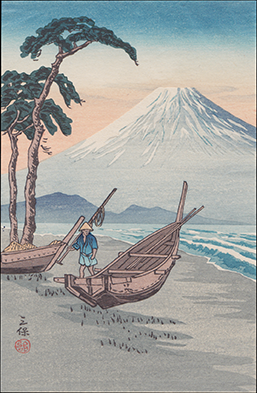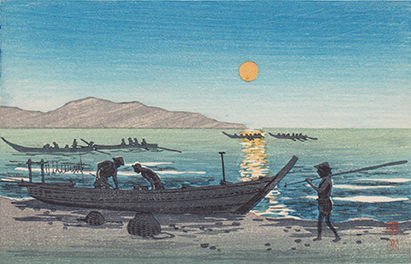Gallery 3A: Takahashi Shōtei
Takahashi Shōtei (1871-1945) was a major artist of the Shin-Hanga movement. In 1907, the publisher Watanabe Shōzaburō, a major influence in the origin of the movement, hired Shōtei as his first artist. Shotei started using the artist name Hiroaki in 1921 but continued to use the Shōtei seal into the 1930s. Additional prints published by Watanabe under the name Rakutei are considered to be by the same artist as are works sealed Kakei. In addition to working with Watanabe, he produced approximately 180 small format prints for the publisher Shōbidō Tanaka; these include the Hiroaki seal.
Extensive information and an online catalogue of his prints can be accessed at Shotei.com which is the primary source for the seals and publishers for Shōtei prints in the collection. Titles on this page reflect those from Shotei.com which are derived primarily from catalogue descriptions (smaller prints are rarely printed with titles) or have been assigned based on image content.
Prints with Hiroaki Seals
The first set of prints are some of the smallest in the collection. They all have the Hiroaki Seal and were published in the 1930s by Shōbidō Tanaka unless otherwise noted. None have formal titles.
Bonsai. 5.0 x 7.3 cm
"Hatsuuma" The First Fete-Day of Inari (The God of Harvest). 9.0 x 12.6 cm
Nigatsu-dō in Nara. 9.7 x 14.2 cm
Prints Published by Watanabe
The following prints were published by Watanabe in the 1930s and 1940s. Titles and numbers refer to their listings in the 1936 Watanabe Catalogue. They bear the Shōtei seal unless otherwise indicated. Many of the prints here and above were intended as attachments for greeting cards. An example is demonstrated below.
Kanegafuchi in Snow; River Sumida. No seal. No. 374. 7.3 x 4.9 cm
Kanegafuchi in Snow; River Sumida. No seal. No. 374. Second copy. 7.3 x 4.9 cm
Fireworks at Ryogoku, River Sumida. 5.9 x 9.1 cm
Another copy is affixed to a Watanabe envelope for a woodblock print set.
Postcard Prints
Several identical designs by Shotei can be found either as separate prints or affixed to postcards. However, Shotei also designed images that only appear as postcards.
Homeward bound boats; blue and golden sky. 1930s. Shotei seal. Design is No. 121 in Watanabe 1936 Catalogue. 13.3 x 8.5 cm (See comparison to unsealed image from Japanese Government Railways). (See image without clouds or postcard back).
Lake Towada , one of the most beautiful mountain Lakes of Japan. From Eight Views of Japan. Published by the Japanese Government Railway. 14.0 x 9.2 cm.
Unzen Peak from Eight Views of Japan. Published for the Japanese Government Railway. 14.0 x 9.2 cm
Kamikochi Valley, a Romantic Valley in the Mountain Region of Japan. From Eight Views of Japan. Published by the Japanese Government Railway. 9.1 x 14.0 cm
Tokachi Plain, in Hokkaido, as seen from the Karikachi Pass. From Eight Views of Japan. Published by the Japanese Government Railway. 14.0 x 9.1 cm
River Kiso near Nagoya. “The Rhine of Japan.” Published by the Japanese Government Railway. 14.1 x 9.2 cm
Kegon Falls, near Nikko, the oulet of Lake Chūzenji . From Eight Views of Japan. 14.1 x 9.0 cm
Beppu, in Kyushu, a Noted Hot Spring Town. From Eight Views of Japan. 14.1 x 9.2 cm
Prints by Mokuhankan
Prints Based on Shotei Images
Due to the popularity of Shotei’s artwork, other publishers reproduced several of his images. Some of these are miniaturizations of larger prints, occasionally with design modifications that might even include adding iconic elements that were thought to increase their marketability to tourists. A good discussion of variants and plagiarized images can be found at Shotei.com and accessed here.
The image to the left is based on Shotei’s chuban sized print Night Scene of Mabashi, near Tokyo. Comparison of this print to the original reveals several modifications to fit the image to the postcard sized format. The original print was published by Watanabe. This smaller image was also produced by Watanabe but does not include an artist seal or signature. This print was included in a packet of prints attached to blank cards that were provided to guests attending tours offered by the Pigeon Bus Company.
The image to the left is an adaptation of Takahashi Shotei’s print Snow at a Shinto Shrine, M-85 at Shotei.com. It represents a cropped image of the original mitsugiri-ban sized print that was published by Shobido Tanaka. This version is unsealed and unsigned. It was included in a set of woodblock prints affixed to blank cards that were said to date from the 1920s, although this dating is questionable. The additional accompanying prints included unsigned miniaturizations by other artists including Asano Takeji.
The image to the left is similar to C-53 at Shotei.com, a chuban sized print with a Kakei seal. Although this miniature print is relatively true to the original design, it’s seal is not a recognized Shotei, Hiroaki, Kakei, or Rakutei seal. Therefore the print appears to be plagiarized version.
This image and the two that follow are three plagiarized Shotei images that are pasted onto a miniature screen with a small 1939 calendar affixed to the back. The image to the left is similar to Sailing Boat in the Rain (S-59 at Shotei.com) except that the rain has cleared and a moon has been substituted for the cloudy sky.
This image is similar to Shrine by River in the collection (S-14 at Shotei.com). In this case an iris garden has been added to the foreground.
Reproduction and Miniaturization of Nihonmatsu. 5.3 x 12.2 cm
The print to the left is a reproduction and miniaturization of the prints M-107 and M-144 at Shotei..com. The pre-earthquake version is sealed Kakei. The post-earthquake print has the Shotei seal. This miniature version is an obvious fake and is signed Hiroshige, a move likely designed to increase sales.
Unsigned variation on Snow at Ozawa; Torii Gate and a Cottage (C-27 at Shotei.com). This miniature woodblock was attached to a blank card of unclear date.





























































































































































